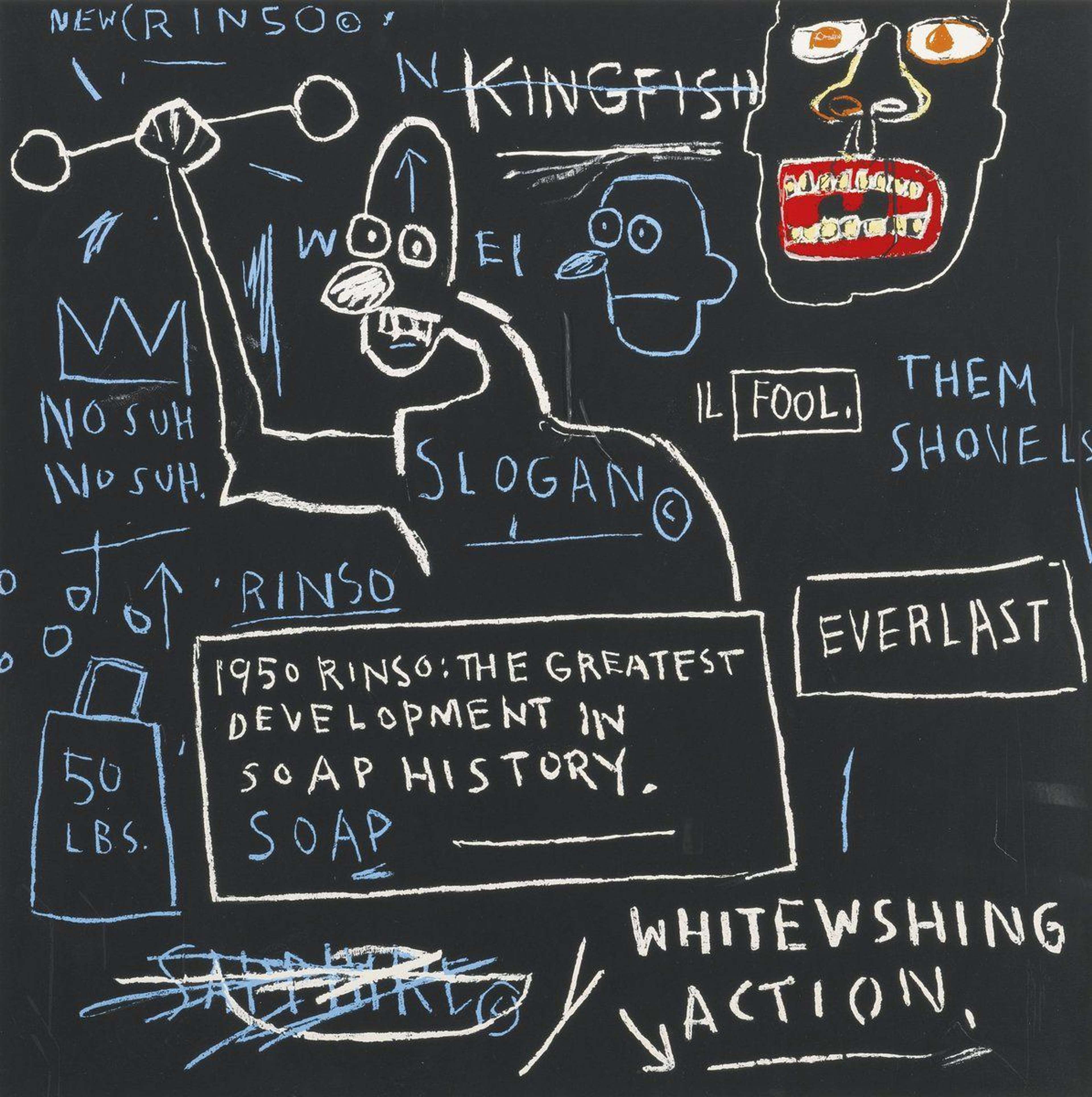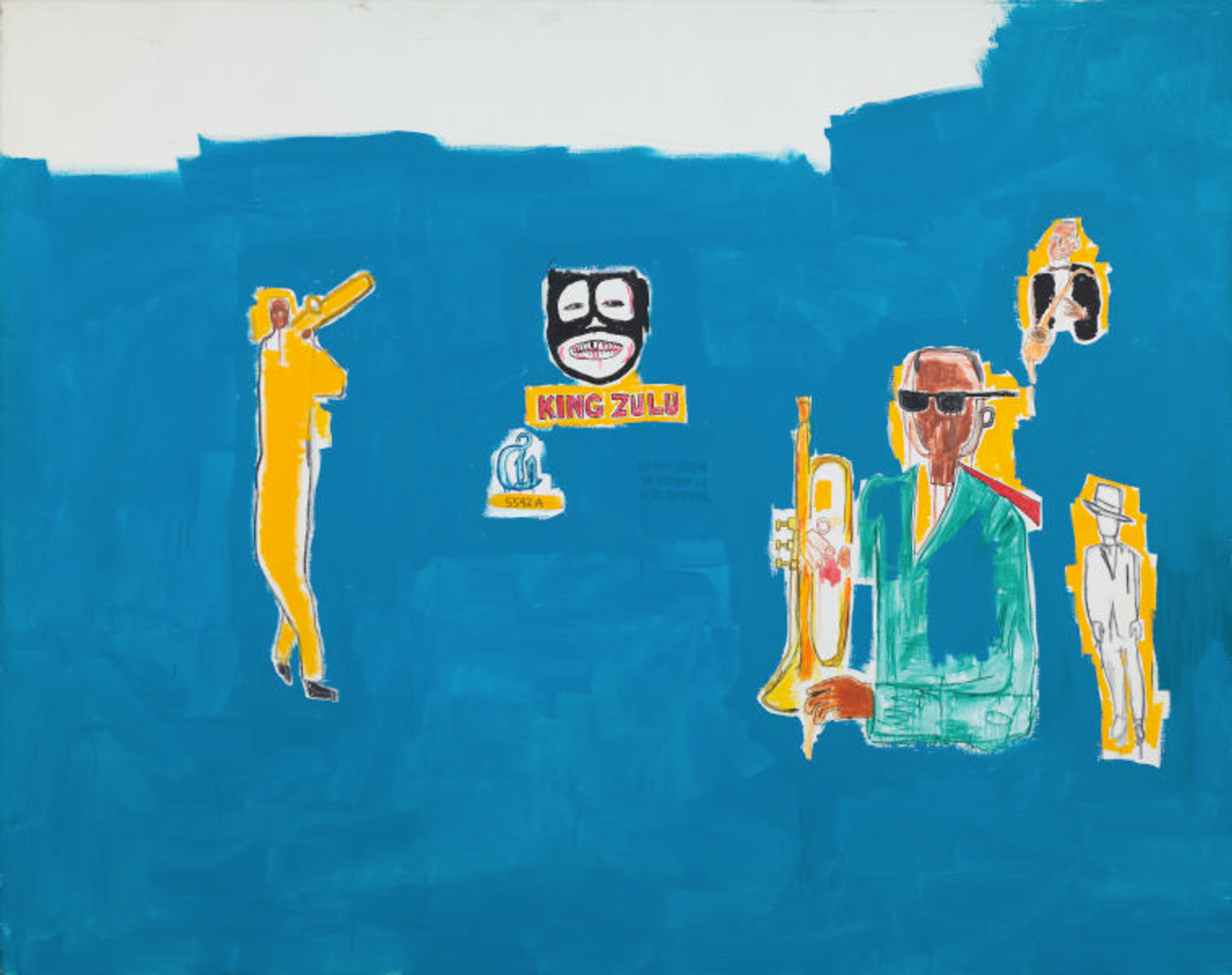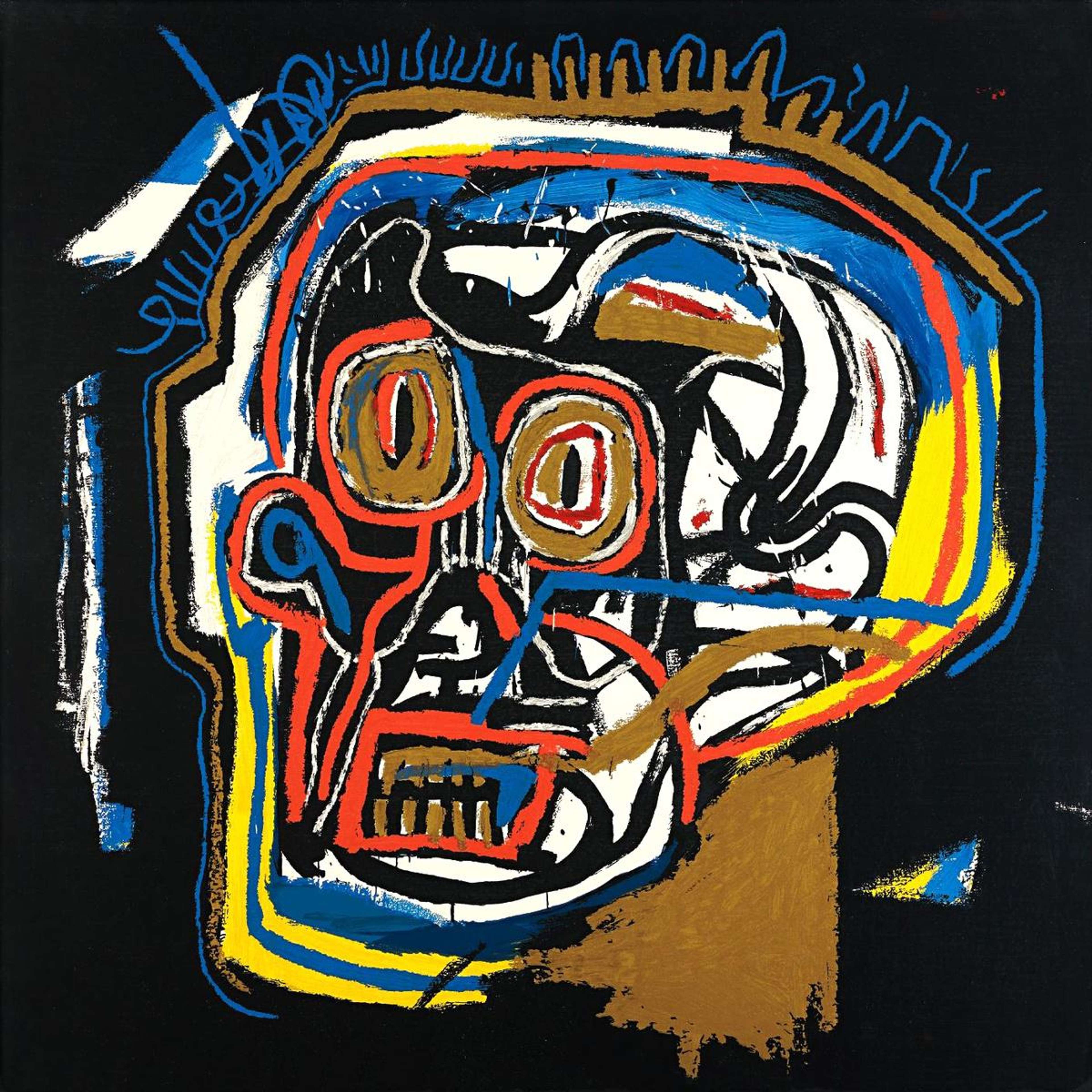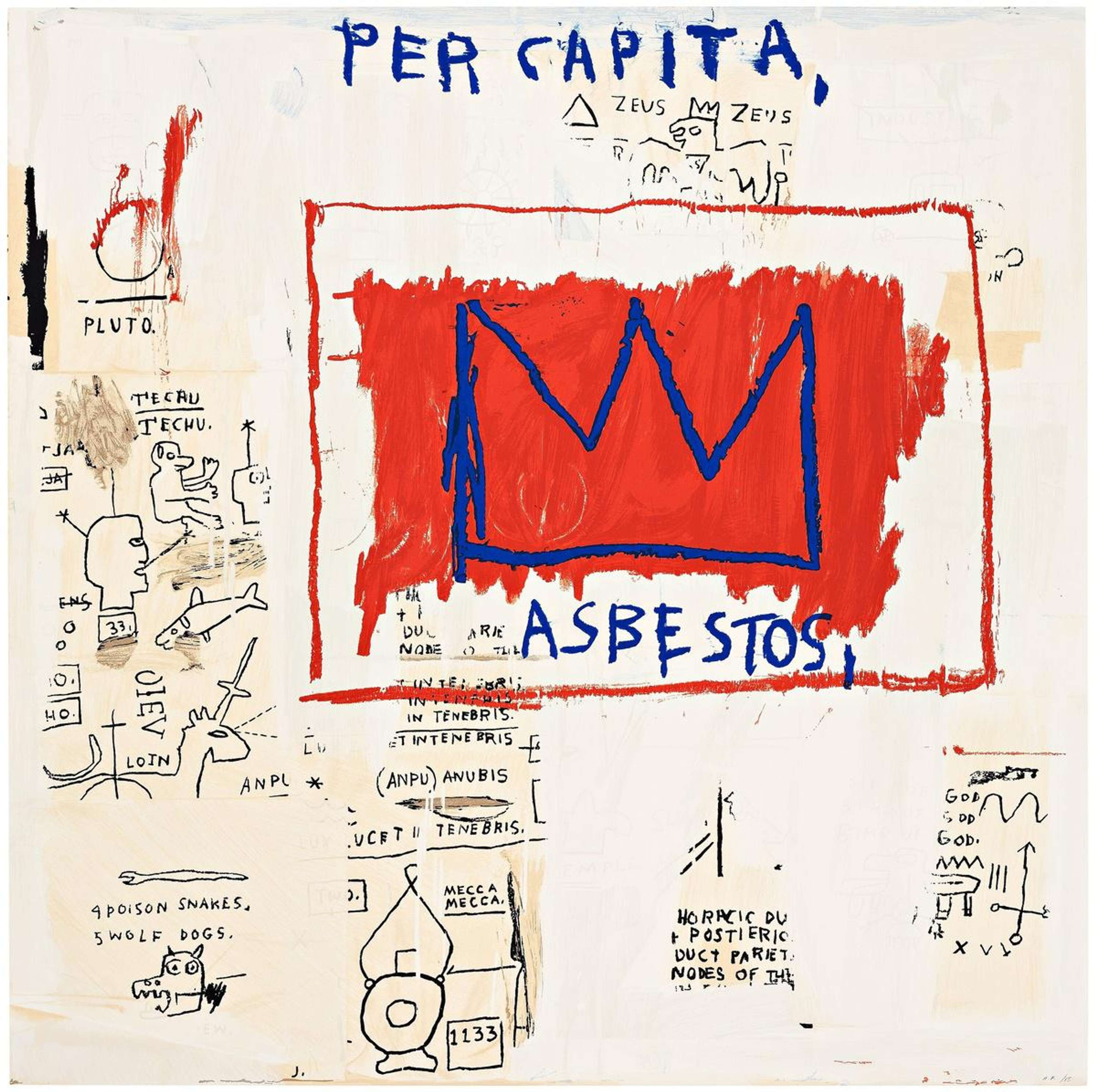 Undiscovered Genius © Jean-Michel Basquiat 1982
Undiscovered Genius © Jean-Michel Basquiat 1982
Interested in buying or selling
Jean-Michel Basquiat?

Jean-Michel Basquiat
57 works
Jean-Michel Basquiat emerged from the gritty New York City street art scene to become one of the most influential artists of the 20th century. By blending graffiti with a distinctive painting style, Basquiat challenged tradition and conveyed powerful messages about race, politics and society. His work, characterised by vibrant, chaotic compositions and compelling symbology, bridged the gap between street art and the elite art world, pushing the boundaries of contemporary art. Basquiat's meteoric rise and tragic early death at the age of 27 only amplified his legend, cementing his status as a cultural icon whose work continues to inspire and provoke.
 Image © Sotheby's / Untitled © Jean-Michel Basquiat 1982
Image © Sotheby's / Untitled © Jean-Michel Basquiat 1982Untitled (1982)
Untitled is a monumental testament to Basquiat's unparalleled prowess in the art world, marking a pivotal moment in his career during the early 1980s. This work encapsulates the essence of Basquiat's innovative approach to art, blending raw, visceral imagery with a complex layering of colours, text, and symbols that capture the viewer's attention with its dynamic intensity and electric charge. The painting serves as a vibrant declaration of Basquiat's arrival on the art scene. Alongside its counterpart in The Broad Museum, this work represents a significant shift in artistic expression, marrying the grit and spontaneity of street art with the formality of canvas-based work. As Basquiat transitioned from street graffiti under the moniker SAMO to more structured canvas work, Untitled exemplifies his ability to retain the immediacy and impact of his street art origins while exploring more complex compositions. Perhaps his most famous piece, this painting sold for over $110 million at auction in 2017, setting a record for the highest price ever paid at auction for an artwork by an American artist until Shot Sage Blue Marilyns by Andy Warhol sold for $195 million in May 2022.
 Image © Creative Commons via Flickr / Boy And Dog In A Johnnypump © Jean-Michel Basquiat 1982
Image © Creative Commons via Flickr / Boy And Dog In A Johnnypump © Jean-Michel Basquiat 1982Boy and Dog in a Johnnypump (1982)
Boy And Dog In A Johnnypump is a vivid and energetic painting that encapsulates the raw emotion and socio-political commentary that define Basquiat's body of work. Created in the seminal year of 1982, this piece is emblematic of Basquiat's unique style, which blends elements of graffiti, Neo-Expressionism, and Primitivism into a visually striking and thought-provoking composition. The painting depicts a figure that can be interpreted as a boy, accompanied by a dog, both situated beside a johnnypump (fire hydrant). The use of a johnnypump as a focal point is significant – it is a symbol deeply rooted in the urban landscape of New York City, where Basquiat lived and worked. It conjures images of summer days, community, and childhood innocence, yet, under Basquiat's brush, it also hints at themes of resistance, oppression, and survival within the city's harsher realities. In 2020, it was purchased for over $100 million by hedge fund manager Kenneth Griffin.
 Image © The Whitney Museum / Hollywood Africans © Jean-Michel Basquiat 1983
Image © The Whitney Museum / Hollywood Africans © Jean-Michel Basquiat 1983Hollywood Africans (1983)
In the collection of the Whitney Museum, Hollywood Africans is a profound critique of the representation and stereotyping of African Americans in the entertainment industry, particularly within the context of Hollywood. This painting is part of Basquiat's broader exploration of identity, race, and power dynamics, themes that are central to much of his work. The work’s title directly addresses the pigeonholing and caricatured portrayals of Black people in Hollywood films and television, highlighting the systemic racism and marginalisation that has historically plagued the industry. The canvas features a trio of figures, believed to represent Basquiat himself alongside his friends, Toxic and Rammellzee, who were also artists and figures within the New York City graffiti scene. The presence of these real individuals serves to ground the painting's critique in the lived experiences of African Americans navigating both the art world and wider societal structures that seek to define them in narrow, often derogatory terms.
 Image © Creative Commons via Flickr / Irony Of A Negro Policeman © Jean-Michel Basquiat 1981
Image © Creative Commons via Flickr / Irony Of A Negro Policeman © Jean-Michel Basquiat 1981Irony of a Negro Policeman (1981)
One of Basquiat's most powerful works, Irony Of A Negro Policeman offers a poignant critique of the role of African Americans within systems of authority that have historically oppressed them. The title itself is a direct commentary on this contradiction. Painted early in his career, this artwork encapsulates Basquiat's skill in using visual language to explore complex socio-political themes, particularly those surrounding race, identity, and power. The painting portrays a black policeman, rendered in Basquiat's signature style that borrows elements from graffiti, Neo-Expressionism, and art brut. The figure is depicted with an oversized, mask-like face and a body adorned with a uniform. It suggests the inherent conflict of being Black and serving in a role that upholds the very structures of racism and oppression against one's own community. Basquiat's use of the word "Negro," an outdated term for African Americans, further emphasises the historical context of this struggle and the systemic racism embedded within American society.
 Image © The Broad Museum / Installation view of Horn Players © Jean-Michel Basquiat
Image © The Broad Museum / Installation view of Horn Players © Jean-Michel Basquiat Horn Players (1983)
Horn Players, in the collection of The Broad Museum, showcases Basquiat’s deep appreciation for jazz music and its influence on his artistic expression. This painting is a vibrant tribute to two legends, saxophonist Charlie Parker and trumpeter Dizzy Gillespie, who were pivotal figures in the development of bebop music. Basquiat's fascination with these musicians is not merely about their musical innovation, but also due to their cultural significance as Black artists who carved out a space for African American creativity and resistance within the broader landscape of American society. The painting is a large diptych, allowing Basquiat to dedicate each panel to one of the musicians, yet he intertwines their legacies through his energetic and symbolic use of text, imagery, and colour. The figures of Parker and Gillespie are rendered in Basquiat's characteristic style, which combines elements of graffiti, abstraction, and figuration. Their instruments and bodies seem to merge, suggesting the inseparable nature of the artists from their art and the profound impact of their music.
 Image © Christie's / Dustheads © Jean-Michel Basquiat 1982
Image © Christie's / Dustheads © Jean-Michel Basquiat 1982Dustheads (1982)
Dustheads encapsulates the energy, chaos, and complexity that define much of Basquiat’s oeuvre. This large canvas is a vivid tableau that features two figures, or "dustheads," immersed in a dynamic and somewhat disorienting landscape that seems to oscillate between abstraction and figuration. The term "dust" was slang for angel dust or PCP, a powerful hallucinogenic drug, and the painting is often interpreted as an exploration of the heightened, distorted state of consciousness induced by such substances. The figures are rendered in Basquiat's signature style, with a raw energy that conveys both movement and emotion. Their bodies are elongated and somewhat disjointed, with exaggerated features and expressions that suggest a state of frenzy or euphoria. These figures dominate the canvas, their presence amplified by the swirling, vibrant colours and chaotic lines that envelop them. The background is a riot of reds, blues, yellows, and blacks, creating a sense of depth and motion that seems to pull the viewer into the painting's frenetic world.
Charles The First (1982)
Charles The First showcases Basquiat's unique ability to intertwine personal and historical narratives with his distinctive iconography and text-based elements. This painting serves as a powerful homage to the legendary jazz saxophonist Charlie Parker, whom Basquiat greatly admired and often referred to by the nickname "Charles the First." Basquiat's fascination with Parker was also rooted in the tragic aspects of his life, including his struggles with addiction and his early death, which Basquiat saw as reflective of the broader experiences of Black Americans and artists – including eventually his own. The canvas is a complex amalgamation of imagery, text, and colour, characteristic of Basquiat's style. It features a crowned figure, representing Parker as a kind of nobility within the realm of jazz and Black culture. Nowadays, the painting is mostly known for inspiring Jay-Z’s song Most Kingz.
Head (1983)
Head is a striking example of his exploration into the human psyche, identity, and expression, distilled into the potent symbol of the head. This painting, like many of Basquiat's works, is characterised by a visceral quality that captures the complexity of the human condition, as well as the artist's own introspections and struggles with fame, identity, and mortality. This work utilises his signature style of bold, outlined figures filled with a frenetic array of symbols and colour. The head is depicted in an almost totemic manner, with features that are simultaneously abstract and deeply expressive. The eyes, often the focal point in Basquiat's heads, are rendered with a penetrating gaze that seems to confront the viewer, suggesting a window into the soul or psyche. This effect is intensified by the chaotic, overlapping layers of paint, drawings, and cryptic symbols that surround and fill the head, indicative of the cluttered and multifaceted nature of human thought and emotion. The use of colour is both vibrant and discordant, with Basquiat employing a palette that contrasts sharply.
Per Capita (1983)
Per Capita delves into themes of economics, race, and inequality, presenting a poignant commentary on the disparities present within American society. Through this painting, Basquiat explores the concept of "per capita" income, a statistical measure that represents the average income earned per person in a given area in a specified year, to critique the distribution of wealth and its implications for African American communities. Dominated by a striking crown outlined in blue against a vibrant red backdrop, the piece immediately draws attention to the theme of royalty or supremacy, offset by the word "ASBESTOS" boldly written in dark blue within a red square. This layering of imagery and colour sets the stage for a series of smaller, detailed sketches that peek through the background, including a variety of creatures and symbols accompanied by text referencing significant historical and religious icons, such as Mecca and Anubis. Per Capita delves into the critique of materialism and the elevation of profit-making to a near-religious status, suggesting a parallel between contemporary societal values and traditional belief systems.
 Cadillac Moon © Jean-Michel Basquiat 1981
Cadillac Moon © Jean-Michel Basquiat 1981Cadillac Moon (1981)
Basquiat’s first sold painting, this was originally purchased by Blondie singer Debbie Harry, who co-starred with the artist on the film Downtown 81. It is a compelling example of Basquiat's exploration of themes such as technology, progress and the American Dream, through his unique visual language. The title itself evokes a sense of Americana, juxtaposing the luxury and status symbolised by Cadillac—a brand often associated with success in American culture—with the ethereal and unreachable nature of the moon. This juxtaposition can be seen as a commentary on the elusive nature of success and the dichotomy between reality and aspiration, themes that recur throughout Basquiat's body of work. Alongside two cards, Basquiat depicts a stack of television sets on the right of the composition, with a single face on each screen. Like most of Basquiat's work, Cadillac Moon pulsates with expressive energy.







